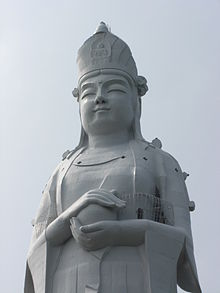Kannon at Tōkyō Bay

The Kannon on the Bay of Tōkyō ( Japanese 東京湾 観 音 Tōkyō-wan Kannon ) is a free-standing, monumental Kannon sculpture on a hill in Futtsu ( Chiba Prefecture ) near Tōkyō .
history
The Kannon on Tōkyō Bay was built by the entrepreneur Masae Usami ( 宇佐美 政 衛 ) in memory of the destruction in the Pacific War and to commemorate world peace in 1961 at his hometown. The Kannon was designed by the sculptor and multiple award winner Hasegawa Kō ( 長谷川 昴 ; 1909-2012), who came from Chiba Prefecture, based on the famous World Redeemer Kannon ( 救世 観 音Kyūse Kannon ) in the Yumedono of Hōryū-ji . It is done a little differently in the lower parts and instead of a water container ( 水瓶 Suibyo ) it carries a ball in its hands. In addition, unlike the prototype, she crosses her arms so that they can accommodate two small platforms that visitors can step out onto.
The attachment
The Kannon is accessible inside. Works by Hasegawa are exhibited there. A spiral staircase leads up 324 steps. You can step outside above the hip of the figure and then have a wide view over the Bay of Tōkyō. In good weather, you can see Mount Fuji in the distance .
An association and the company of the founder look after the monument. There is a fee to climb inside.
Data
- Height above ground: 56 m
- Foundation: 16 pillars, each 10 m long
- Mass: 4800 tons, 280 tons of which are steel
- Inside steps: 324
- Workers involved: 12,000
- Opening: September 18, 1961
Remarks
- ↑ Usami was born in Kimitsu (Chiba Prefecture) and went to Tōkyō at the age of 14 to earn money. He achieved prosperity with the timber trade, then experienced the horror of the Pacific War and decided to erect a memorial for peace in memory of the many civilian deaths in the bombing raids in spring 1945.
Web links
Coordinates: 35 ° 15 '48.3 " N , 139 ° 51' 44.8" E